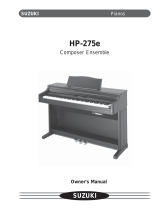
03
Contents
Panel & Display Description
Front Panel............................................................................4
Rear Panel............................................................................5
LCD Display...........................................................................5
Setup
Power Supply........................................................................6
Setting a Music Rest..............................................................6
Connections
Connecting a Computer........................................................7
Connecting a Foot Switch.....................................................7
Connecting a pair of Headphones........................................7
Connecting an Audio Equipment...........................................7
Power/Master Volume
Turn the Power On/ Off.........................................................8
Adjust the Master Volume.....................................................8
Playing Demo Songs..........................................................8
Playing Voices.....................................................................9
Playing Styles......................................................................9
Playing Songs...................................................................10
Record................................................................................10
Voices
Select a Voice......................................................................11
Playing two voices simultaneously-DUAL...........................11
Playing Different Voices with Both hands-LOWER..............11
Auto Accompaniment
Play Auto Accompaniment (rhythm track only)....................12
Play Auto Accompaniment(all tracks)..................................12
Accompaniment Sections....................................................12
Playing Different Accompaniment Sections.........................13
Fade....................................................................................13
Accompaniment Volume Control.........................................14
Chord Fingering..................................................................14
Tempo.................................................................................15
Function Menu
Tune....................................................................................16
Split Point............................................................................16
Beat Type............................................................................17
Pedal Type..........................................................................17
EQ Type..............................................................................17
Reverb Type........................................................................17
Reverb Level.......................................................................18
Chorus Type........................................................................18
Chorus Level.......................................................................18
Harmony..............................................................................18
MIDI IN/ OUT......................................................................19
Auto Power Off....................................................................19
Mixer...................................................................................19
Effect Related Settings
Octave.................................................................................20
Touch..................................................................................20
Metronome..........................................................................20
Sustain................................................................................20
Pitch Bend...........................................................................20
DSP.....................................................................................21
Transpose...........................................................................21
Harmony..............................................................................21
Register Memory
Registering the Panel Setting..............................................22
Recalling the Registered Panel Settings.............................22
Selecting a Registration Bank.............................................22
One Touch Setting.............................................................23
Record
Prepare for Recording.........................................................23
Start Recording...................................................................24
Stop Recording...................................................................24
Playback Recording............................................................24
Delete Recording.................................................................24
Playing the Demo Song....................................................25
Piano Mode........................................................................25
Song
Listening to the Songs.........................................................26
Song Control.......................................................................26
Lesson Mode.......................................................................26
Chord Dictionary
DICT 1 (Chord Learning Mode)...........................................28
DICT 2 (Chord Testing Mode)..............................................28
Exit Chord Dictionary...........................................................28
Pedal Function
Multi-function Pedal.............................................................29
MIDI
What's MIDI?.......................................................................30
The main application of MIDI..............................................30
Troubleshooting................................................................31
Specifications....................................................................32
Appendices
Voice List.............................................................................33
Style List..............................................................................39
Song List.............................................................................42
Demo List............................................................................43
MIDI Implementation Chart.................................................44





















